奈达翻译理论研究 第一章 笔记
- 格式:doc
- 大小:46.00 KB
- 文档页数:4
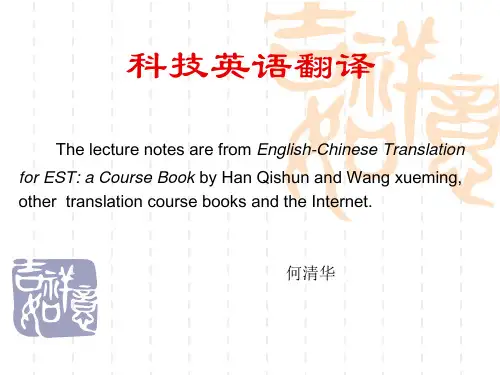

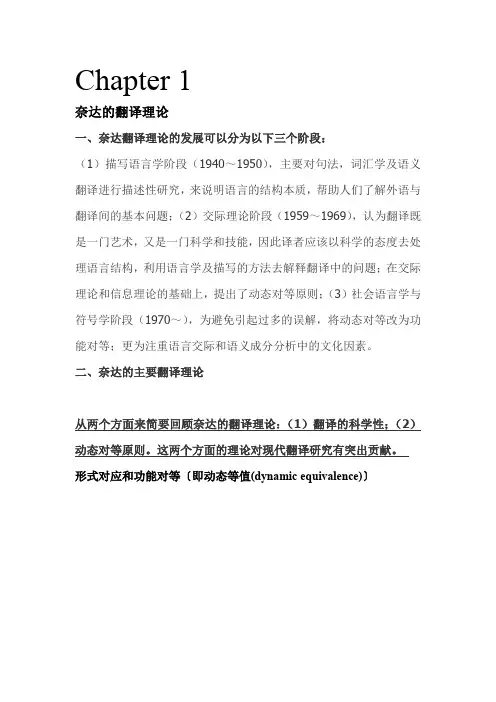
Chapter 1奈达的翻译理论一、奈达翻译理论的发展可以分为以下三个阶段:(1)描写语言学阶段(1940~1950),主要对句法,词汇学及语义翻译进行描述性研究,来说明语言的结构本质,帮助人们了解外语与翻译间的基本问题;(2)交际理论阶段(1959~1969),认为翻译既是一门艺术,又是一门科学和技能,因此译者应该以科学的态度去处理语言结构,利用语言学及描写的方法去解释翻译中的问题;在交际理论和信息理论的基础上,提出了动态对等原则;(3)社会语言学与符号学阶段(1970~),为避免引起过多的误解,将动态对等改为功能对等;更为注重语言交际和语义成分分析中的文化因素。
二、奈达的主要翻译理论从两个方面来简要回顾奈达的翻译理论:(1)翻译的科学性;(2)动态对等原则。
这两个方面的理论对现代翻译研究有突出贡献。
形式对应和功能对等〔即动态等值(dynamic equivalence)〕他认为形式对应是指代表源语词或句在目的语中最切近的具有对等功能的词或句,在语言对之间并不总存在着形式对应,要根据原文语体来决定使用形式对应还是动态等值。
他根据乔姆斯基的转换生成语法而提出翻译的“功能对等”说,将翻译的过程归纳为三步:分析-转换一重构,以达到理解原文语义与基本结构,在此基础上转达语义,最终获得与原文语义和语体上的对等。
三、对等理论的适用范围许多翻译家都认为其理论是不适合文学翻译的。
以诗歌翻译为例,林语堂曾经说过:“诗乃最不可译的东西。
无论古今中外,最好的诗(而尤其是抒情诗)都是不可译的。
”辜正坤在《中西诗比较鉴赏与翻译理论》一书中所言,“凡属语言本身的固有属性(区别于他种语言)的东西往往都不可译”。
针对这一问题,郭建中表示奈达的功能对等并不一定适用所有的文体和一切的翻译目的,他指出:“哲学、历史、科技等著作,要求如实地传达原文的内容,不能迁就目的语的读者水平或目的语的文化规范。
”四、对等理论的形式与内容之争所谓形式与内容之争,是由奈达的一句话引来的。
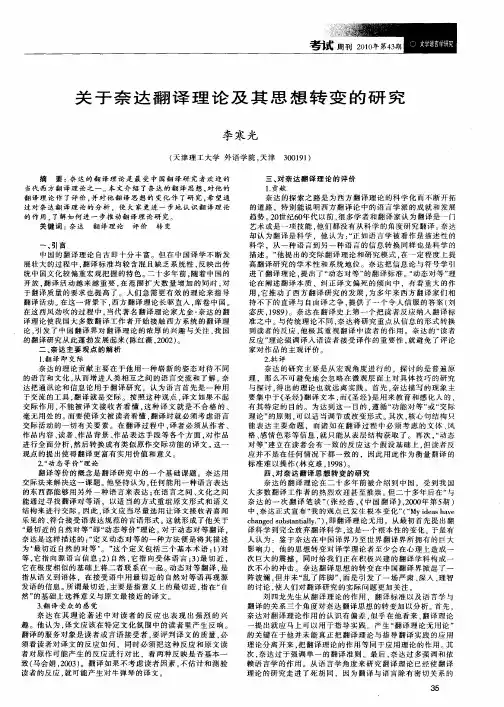
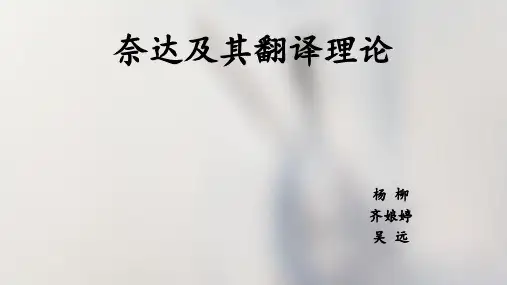
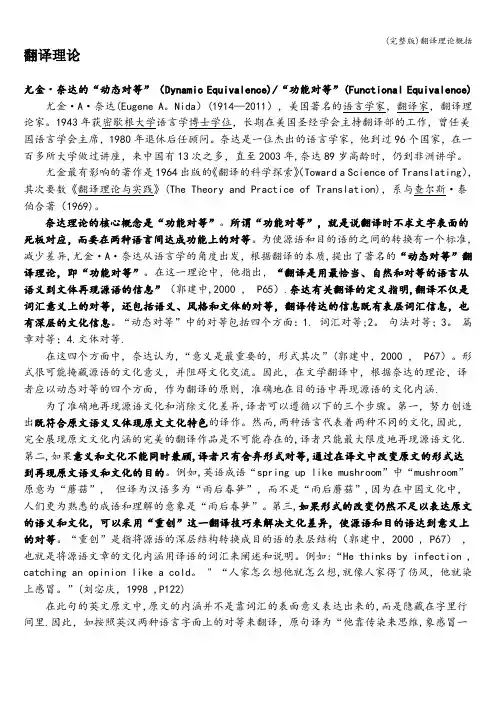
翻译理论尤金·奈达的“动态对等”(Dynamic Equivalence)/“功能对等”(Functional Equivalence)尤金·A·奈达(Eugene A。
Nida)(1914—2011),美国著名的语言学家,翻译家,翻译理论家。
1943年获密歇根大学语言学博士学位,长期在美国圣经学会主持翻译部的工作,曾任美国语言学会主席,1980年退休后任顾问。
奈达是一位杰出的语言学家,他到过96个国家,在一百多所大学做过讲座,来中国有13次之多,直至2003年,奈达89岁高龄时,仍到非洲讲学。
(Toward a Science of Translating),尤金最有影响的著作是1964出版的《翻译的科学探索》其次要数《翻译理论与实践》(The Theory and Practice of Translation),系与查尔斯·泰伯合著(1969)。
奈达理论的核心概念是“功能对等”。
所谓“功能对等”,就是说翻译时不求文字表面的死板对应,而要在两种语言间达成功能上的对等。
为使源语和目的语的之间的转换有一个标准,减少差异,尤金·A·奈达从语言学的角度出发,根据翻译的本质,提出了著名的“动态对等”翻译理论,即“功能对等”。
在这一理论中,他指出,“翻译是用最恰当、自然和对等的语言从语义到文体再现源语的信息”(郭建中,2000 , P65).奈达有关翻译的定义指明,翻译不仅是词汇意义上的对等,还包括语义、风格和文体的对等,翻译传达的信息既有表层词汇信息,也有深层的文化信息。
“动态对等”中的对等包括四个方面:1. 词汇对等;2。
句法对等;3。
篇章对等;4.文体对等.在这四个方面中,奈达认为,“意义是最重要的,形式其次”(郭建中,2000 , P67)。
形式很可能掩藏源语的文化意义,并阻碍文化交流。
因此,在文学翻译中,根据奈达的理论,译者应以动态对等的四个方面,作为翻译的原则,准确地在目的语中再现源语的文化内涵.为了准确地再现源语文化和消除文化差异,译者可以遵循以下的三个步骤。
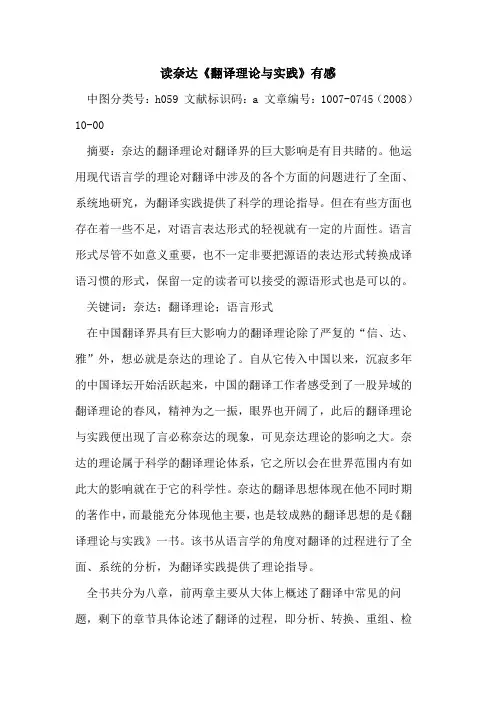
读奈达《翻译理论与实践》有感中图分类号:h059 文献标识码:a 文章编号:1007-0745(2008)10-00摘要:奈达的翻译理论对翻译界的巨大影响是有目共睹的。
他运用现代语言学的理论对翻译中涉及的各个方面的问题进行了全面、系统地研究,为翻译实践提供了科学的理论指导。
但在有些方面也存在着一些不足,对语言表达形式的轻视就有一定的片面性。
语言形式尽管不如意义重要,也不一定非要把源语的表达形式转换成译语习惯的形式,保留一定的读者可以接受的源语形式也是可以的。
关键词:奈达;翻译理论;语言形式在中国翻译界具有巨大影响力的翻译理论除了严复的“信、达、雅”外,想必就是奈达的理论了。
自从它传入中国以来,沉寂多年的中国译坛开始活跃起来,中国的翻译工作者感受到了一股异域的翻译理论的春风,精神为之一振,眼界也开阔了,此后的翻译理论与实践便出现了言必称奈达的现象,可见奈达理论的影响之大。
奈达的理论属于科学的翻译理论体系,它之所以会在世界范围内有如此大的影响就在于它的科学性。
奈达的翻译思想体现在他不同时期的著作中,而最能充分体现他主要,也是较成熟的翻译思想的是《翻译理论与实践》一书。
该书从语言学的角度对翻译的过程进行了全面、系统的分析,为翻译实践提供了理论指导。
全书共分为八章,前两章主要从大体上概述了翻译中常见的问题,剩下的章节具体论述了翻译的过程,即分析、转换、重组、检测。
第一章简要介绍了一些关于翻译的新观点,如翻译的重点从语言形式转向读者反应,这是奈达翻译思想的核心内容。
此外,他还认为语言是有共性的,尽管各种语言都有各自的特点,一种语言能表达的事情也能用另一种语言表达。
他在第二章提出了动态对等的观点,认为翻译是在译语中用最切近而又最自然的对等语再现源语的信息,首先是意义,其次是形式,使译文读者对译文的反应与原文读者对原文的反应一致,强调了读者在翻译过程中的重要地位。
第三章开始论述翻译过程中的第一步——分析,介绍了语法分析的过程,把词从语义角度分成了物体词、活动词、抽象词和关系词来替代传统的语法分类,并提出了七个核心句和五个步骤来分析句子成分,为译者正确理解原文含义提供了科学的理论指导。
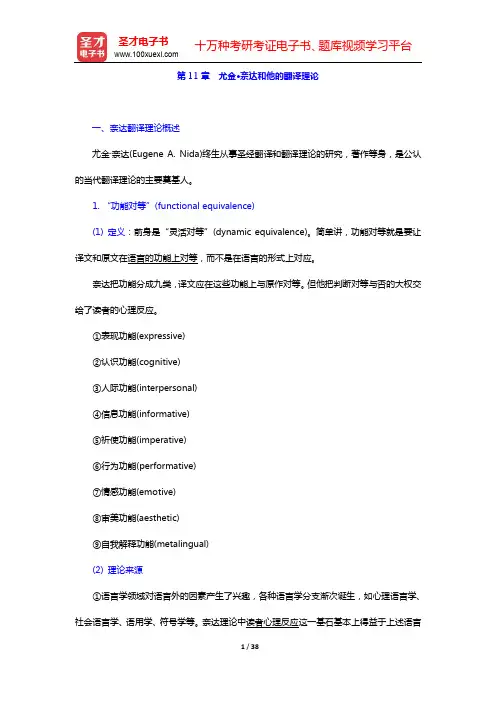
第11章尤金·奈达和他的翻译理论一、奈达翻译理论概述尤金·奈达(Eugene A. Nida)终生从事圣经翻译和翻译理论的研究,著作等身,是公认的当代翻译理论的主要奠基人。
1. “功能对等”(functional equivalence)(1) 定义:前身是“灵活对等”(dynamic equivalence)。
简单讲,功能对等就是要让译文和原文在语言的功能上对等,而不是在语言的形式上对应。
奈达把功能分成九类,译文应在这些功能上与原作对等。
但他把判断对等与否的大权交给了读者的心理反应。
①表现功能(expressive)②认识功能(cognitive)③人际功能(interpersonal)④信息功能(informative)⑤祈使功能(imperative)⑥行为功能(performative)⑦情感功能(emotive)⑧审美功能(aesthetic)⑨自我解释功能(metalingual)(2) 理论来源①语言学领域对语言外的因素产生了兴趣,各种语言学分支渐次诞生,如心理语言学、社会语言学、语用学、符号学等。
奈达理论中读者心理反应这一基石基本上得益于上述语言学方面的发展。
②乔姆斯基(Noam Chomsky)的转换生成语法。
乔姆斯基的早期理论中有关语言表层结构和深层结构转换的模式在很大程度上为奈达描写功能对等提供了工具。
2. 奈达的研究重心的变化(1) 早期的奈达从语言内营造他功能对等的理论,用了诸如转换生成语法、语义成分分析等具体方法来描写他的理论。
发表于1964年的Toward a Science of Translating,主要在语言学的框架下讨论翻译(也涉及了语言外的因素)。
他在该书中将语义细分成语法意义(linguistic meaning)、所指意义(referential meaning)和情感意义(emotive meaning)。
(2) 越往后,奈达就越重视社会文化因素。
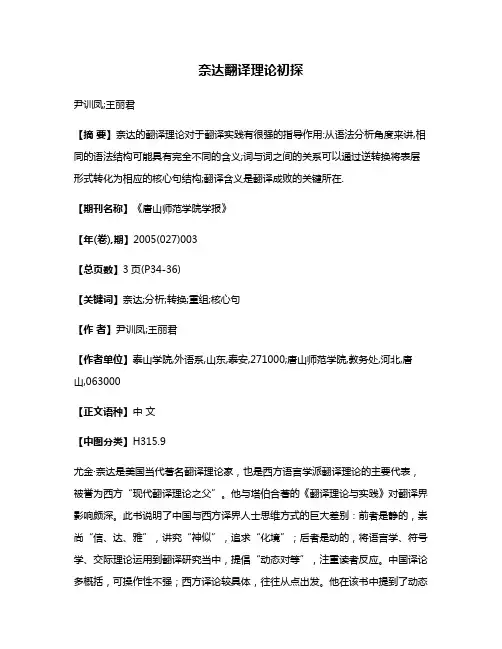
奈达翻译理论初探尹训凤;王丽君【摘要】奈达的翻译理论对于翻译实践有很强的指导作用:从语法分析角度来讲,相同的语法结构可能具有完全不同的含义;词与词之间的关系可以通过逆转换将表层形式转化为相应的核心句结构;翻译含义是翻译成败的关键所在.【期刊名称】《唐山师范学院学报》【年(卷),期】2005(027)003【总页数】3页(P34-36)【关键词】奈达;分析;转换;重组;核心句【作者】尹训凤;王丽君【作者单位】泰山学院,外语系,山东,泰安,271000;唐山师范学院,教务处,河北,唐山,063000【正文语种】中文【中图分类】H315.9尤金·奈达是美国当代著名翻译理论家,也是西方语言学派翻译理论的主要代表,被誉为西方“现代翻译理论之父”。
他与塔伯合著的《翻译理论与实践》对翻译界影响颇深。
此书说明了中国与西方译界人士思维方式的巨大差别:前者是静的,崇尚“信、达、雅”,讲究“神似”,追求“化境”;后者是动的,将语言学、符号学、交际理论运用到翻译研究当中,提倡“动态对等”,注重读者反应。
中国译论多概括,可操作性不强;西方译论较具体,往往从点出发。
他在该书中提到了动态对等,详细地描述了翻译过程的三个阶段:分析、转换和重组,对于翻译实践的作用是不言而喻的。
笔者拟结合具体实例,从以下角度来分析其理论独到之处。
一般来说,结构相同的词组、句子,其语法意义是相同或相近的。
然而奈达提出,同样的语法结构在许多情况下可以有不同的含义。
“名词+of+名词”这一语法结构可以对此作最好的阐释。
如下例:(1)the plays of Shakespeare/ the city of New York/ the members of the team/ the man of ability/ the lover of music/ the order of obedience/ the arrival of the delegation在以上各个词组中,假设字母A和B分别代表一个名词或代词,它们之间存在着不同的关系。
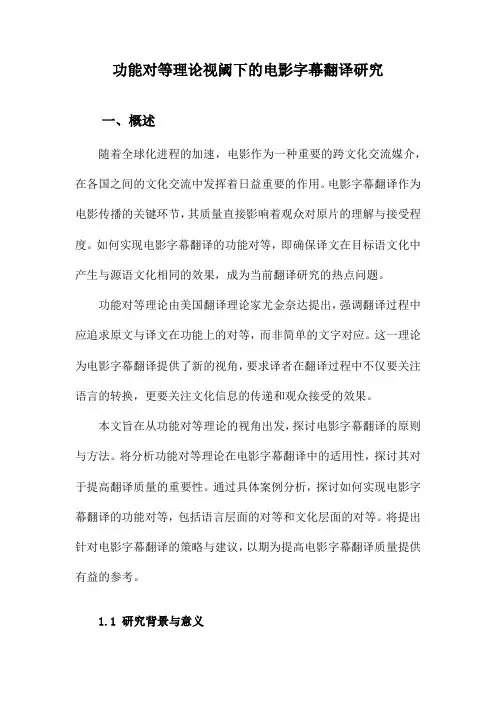
功能对等理论视阈下的电影字幕翻译研究一、概述随着全球化进程的加速,电影作为一种重要的跨文化交流媒介,在各国之间的文化交流中发挥着日益重要的作用。
电影字幕翻译作为电影传播的关键环节,其质量直接影响着观众对原片的理解与接受程度。
如何实现电影字幕翻译的功能对等,即确保译文在目标语文化中产生与源语文化相同的效果,成为当前翻译研究的热点问题。
功能对等理论由美国翻译理论家尤金奈达提出,强调翻译过程中应追求原文与译文在功能上的对等,而非简单的文字对应。
这一理论为电影字幕翻译提供了新的视角,要求译者在翻译过程中不仅要关注语言的转换,更要关注文化信息的传递和观众接受的效果。
本文旨在从功能对等理论的视角出发,探讨电影字幕翻译的原则与方法。
将分析功能对等理论在电影字幕翻译中的适用性,探讨其对于提高翻译质量的重要性。
通过具体案例分析,探讨如何实现电影字幕翻译的功能对等,包括语言层面的对等和文化层面的对等。
将提出针对电影字幕翻译的策略与建议,以期为提高电影字幕翻译质量提供有益的参考。
1.1 研究背景与意义随着全球化的不断深入和多媒体技术的飞速发展,电影作为一种集视觉与听觉于一体的艺术形式,已经成为了跨文化交流的重要媒介。
电影字幕翻译作为电影传播的关键环节,对于确保电影信息的准确传递、促进不同文化间的相互理解具有举足轻重的地位。
由于电影语言的特殊性,如口语化、俚语化、文化负载词的大量使用等,使得电影字幕翻译面临诸多挑战。
如何确保电影字幕翻译在传递原文语义信息的同时,也能准确传达原文的风格特点和文化内涵,成为了翻译界亟待解决的问题。
功能对等理论是由美国翻译理论家尤金奈达提出的,它强调翻译应以实现原文与译文在功能上的对等为主要目标。
这一理论为电影字幕翻译提供了新的视角和理论指导。
本研究旨在探讨功能对等理论在电影字幕翻译中的应用,分析其在确保电影信息准确传递、保持原文风格特点和文化内涵方面的作用,以期为电影字幕翻译实践提供有益的参考和借鉴。
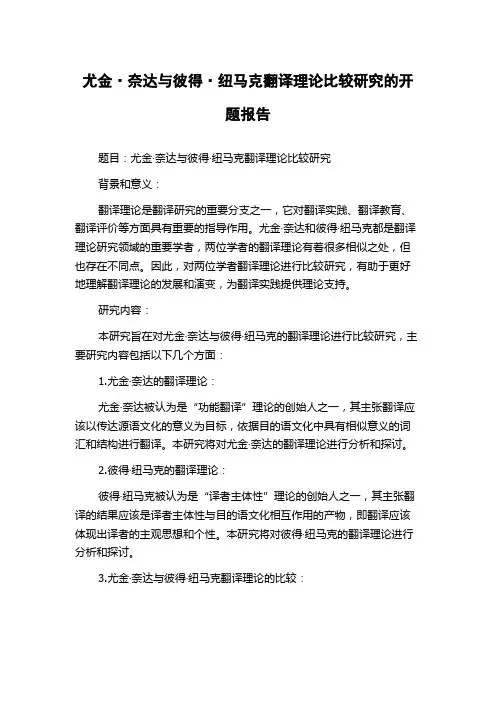
尤金·奈达与彼得·纽马克翻译理论比较研究的开题报告题目:尤金·奈达与彼得·纽马克翻译理论比较研究背景和意义:翻译理论是翻译研究的重要分支之一,它对翻译实践、翻译教育、翻译评价等方面具有重要的指导作用。
尤金·奈达和彼得·纽马克都是翻译理论研究领域的重要学者,两位学者的翻译理论有着很多相似之处,但也存在不同点。
因此,对两位学者翻译理论进行比较研究,有助于更好地理解翻译理论的发展和演变,为翻译实践提供理论支持。
研究内容:本研究旨在对尤金·奈达与彼得·纽马克的翻译理论进行比较研究,主要研究内容包括以下几个方面:1.尤金·奈达的翻译理论:尤金·奈达被认为是“功能翻译”理论的创始人之一,其主张翻译应该以传达源语文化的意义为目标,依据目的语文化中具有相似意义的词汇和结构进行翻译。
本研究将对尤金·奈达的翻译理论进行分析和探讨。
2.彼得·纽马克的翻译理论:彼得·纽马克被认为是“译者主体性”理论的创始人之一,其主张翻译的结果应该是译者主体性与目的语文化相互作用的产物,即翻译应该体现出译者的主观思想和个性。
本研究将对彼得·纽马克的翻译理论进行分析和探讨。
3.尤金·奈达与彼得·纽马克翻译理论的比较:通过对尤金·奈达与彼得·纽马克的翻译理论进行比较,探讨两位学者在翻译理论上的异同点,并从理论的角度探讨其对翻译实践的指导作用,为翻译实践提供理论支持。
研究方法:本研究采用文献资料法和实证分析法进行研究。
通过查阅相关文献,了解尤金·奈达与彼得·纽马克的翻译理论,分析两位学者理论的相似之处和不同点,探讨其对翻译实践的指导作用。
同时通过实证分析法,对两位学者翻译理论进行实证研究,考察其在具体翻译实践中的应用情况。
预期成果:通过对尤金·奈达与彼得·纽马克的翻译理论比较研究,本研究将得出以下成果:1.分析解释尤金·奈达与彼得·纽马克的翻译理论,并比较两位学者理论的异同点。
NotesChapter oneIn the 1960s, Nida only dealt with "grammatical meaning", "referential meaning" and "associative meaning". In the 1980s "rhetorical meaning" was added to his book From One Language to Another.Chapter two1. 中国传统绘画理论重“神似”。
《淮南子》中说,“画西施之画,美而不可说;规孟贲之目,大而不可畏,君形者亡焉”。
东晋画家顾恺之也明确提出“以形写神”的说法。
2. Nida's definition of translating may be put into Chinese as "翻译是在译入语中用最贴近、最自然的对等语再现原语的信息,首先是语义上的对等,其次是风格上的对等。
3. Nida's "dynamic equivalence" is defined "in terms of the degree to which the receptors of the message in the receptor language respond to it in substantially the same manner as the receptor in the source language"; while Newmark's "communicative translation" attempts to produce on its original". Comparing the two definitions, we can see that both of them emphasize readers' acceptability of the translated message and the dynamic relationship between readers and texts.Chapter three1. Nida employs the expression "receptor language" to refer to the language into which one translates. In his opinion, the traditional expression "target language" is not proper, for in translating "one does not merely shoot the communication at a target. Rather, the communication must be received". Clearly, the use of "receptor language" emphasizes that "the message must be decoded by those who receive ti".2. In Toward a Science of Translation (1969), Nida put forward his "science of translation" in a systematic manner. In the 1970s, however, he gave up his idea and claimed that translation was an art rather than a science. In the preface to The Theory and Practice of Translation (1974), Nida stated that "translating is far more than a science. It is also a skill, and in the ultimate analysis fully satisfactory translation is always an art". Since then Nida no longer took translation as a science.3. As early as 1964, Nida tried to define a dynamic equivalent translation. He stated that one way of defining a D-E translation was to describe it as "the closest natural equivalent to the source-language message". This definition contains three essential terms: (1) equivalent, which points toward the source-language message, (2) natural, which points toward the receptor language, (3) closest, which binds the two orientations together on the basis of the highest degree of approximation.Chapter four1. In the 1930s, Qu Qiubai wrote: A translation should introduce completely and correctly the content of the original text to the Chinese reader so that he can obtain an idea as same as that of the English, Russion, Japanese, German or French reader couldget from the corresponding original text. One should not tolerate "awkwardness to a certain degree" for the sake of retaining the spirit of the original text. On the expense of the loss of the original spirit.2. As Jin's says, his translation is neither a literal nor a free translation, because he only takes account of how to achieve the objective of "equivalent effect" in translating. Similarly, Nida's "dynamic equivalence" is not opposed to literal translation on condition that they can achieve the goal of equivalent effect.3. In "An Interview with Professor Jin Di" (2000), he states: the three translation criteria "faithfulness, expressiveness and spirit resemblance" I put forward, which is based on Y an's principle, are completely the same as my theory of "equivalent effect". For me, to strive for these criteria is actually for the objective of "equivalent effect.Chapter five夫人之立言,因字而生句,积句而成章,积章而成篇。
读奈达《翻译理论与实践》有感英国译论家雅各布奈达(JacobNeusner)的《翻译理论与实践》一书出版于2020年,用他广泛的学术生涯重新定义了翻译领域。
这本书被誉为翻译理论和实践新史的开创者,其中的理论历史概念非常具有深远的意义,构建了翻译领域的新框架。
翻译理论贯穿于《翻译理论与实践》的整体构架中,从关于翻译作品及后续文献研究的理念,到作品进行完整性概念的介绍,以及有关不同翻译方法及其应用的探究,实践概念也是书中的重要议题。
该书中的许多观点和术语反映了当今时代翻译理论的观点,而它们对翻译研究的发展起到了不可估量的作用。
一方面,《翻译理论与实践》的第一部分介绍了翻译理论的基础和历史。
奈达认为,翻译是一个语言和文化媒介,它可以将新的内容转化成客观信息,以供不同语言文化之间的理解。
其次,奈达指出,翻译应该与现代社会文化、政治和信仰观念相结合,因此,翻译首先必须考虑文字的文化意义,而不仅仅关注历史、拼写和语法。
归结起来,奈达追求翻译的可持续性,以保护传统文化,发展非政治化的社会环境,提升全球多样性。
另一方面,书中第二部分介绍了《翻译理论与实践》的实践概念,尤其是它的十六个翻译方法,该方法建立在奈达的3个主要翻译原则之上,包括:第一,翻译应该是一个语言和文化的中介;第二,它应该与现代社会文化,政治和信仰观念相结合;第三,它应该允许读者接受文本的内涵。
此外,该书还介绍了如何实施这些方法,包括采用社会化翻译和奈达翻译语言论并重新审视翻译的语言与文化关系。
总而言之,《翻译理论与实践》开创了翻译领域的新概念,它的理论历史概念及翻译原则为翻译研究发展和实践提供了指导,有助于改善翻译质量,并保护传统文化,促进全球多样性发展。
人们在阅读该书时,可以更深入地理解翻译理论,从而更加有效地翻译文本。
奈达翻译理论研究A Study on Nida’s Translation Theory 马会娟著English AbstractThis book makes a systematic research on Nida’s translation theory, clarify some misunderstandings concerning his theory, disclose its true nature and explore its validity and limitations in literary translations. Examples from Today’s English V ersion and Today’s Chinese V ersion of the Bible, which were translated, following Nida’s translation theory, demonstrate that Nida’s theory, contrary to some popular wrong assumptions, is applicable to translation practice between foreign languages and Chinese. A comparative study of Nida’s theory and Jin Di’s theory is made to reveal the similarities and differences between the two theories, and the reasons for their discrepancies are also explored. Examples from Jin’s Chinese translation of Ulysses are examined against the principle of “equivalent effect”. This book also explores the limitations of Nida’s theory in literary translation, pointing out that his theory fails to address the issue of transference of aesthetic values of literary work into another language. Attempts have been made to amend Nida’s theory in respect of transferring aesthetic values of literary work by means of “formal aesthetic markers”and “non-formal aesthetic markers”, with aim of marking it more suitable for literary translation between Chinese and English.CHAPTER ONE Introduction1.1 Reasons for further research on Nida’s translation theoryHis works on translation set off the study of modern translation as an academic field ( Snell—Hornby, Heylen, Baker)Before his theory was introduced into China in the 1980s, people mainly focused attention on traditional Chinese theories, especially Y an Fu’sthree—character principle of translation: faithfulness, smoothness and elegance.Since Nida’s theory was grounded solidly on contemporary developments of linguistics, communication theory, information theory, semiotics andanthropology, Chinese translation scholars took great interest in his theory.Chang Namfung summarizes 4 kinds of misunderstandings regarding Nida’s theory in China:1)“Dynamic equivalence” is only an ideal translation ctiterion2)Nida’s theory is unfit to guide translation practice between Chinese andEnglish because it grows out of translation experience amongIndo—European language3)Nida’s takes “reader’s response” as a translation criterion in evaluatingtranslation4)Nida doesn’t respect the cultural factors in the source language and hismaintenance of complete naturalization in translating is a kind ofcultural hegemonism.The term “equivalence” in Nida’s theory never means “identical”, but only “substantially the same”.“dynamic equivalence” is founded on information theory, and is has on directrelationship with “reception aesthetics” or “reader-response theory” at all.Nida’s discussion about kernels and deep structures is based on semantic level while Chomsky focuses on syntactical level.Nida’s “science of translation” is totally different from the debates of the debate of whether “translation is a science or an art” occurring among some Chinese scholars. When Nida talks about “science of translation”, what he means is that he tends to “deal with the process of translation in a scientific manner”, drawing on the theoriesof linguistics, information and communication, etc.1.2 A profile of Nida1.2.3 His academic contributions to modern linguistics and translationEric M. North, the former General Secretary of the American Bible Society of the American Bible society, divides Nida’s academic activity into 4 phases on his writings in chronological order:1)the phase of descriptive linguistics, 1943—19512)the phase of cross—cultural communication. 1952—19603)the translation phase, 1961—19734)the semantic phase, 1974—Message and Mission was the most significant book of the second phase. Gentzler suggested that it was in this book that Nida first outlined his translation theory. This book marked the beginning of the third phase.In the third phase, in the book, Toward a Science of Translating, Nida firsta dvanced the proposition of “dynamic equivalence”, and the three-stage model of the translation process:“analysis, transfer and restructuring”. It is commonly agreed that Toward a Science of Translating best summarizes the various aspects of his translation theory.For Nida, translating means translating meaning.The most representative book of this phase was From One Language to Another. In this book, Nida not only further explored the issues of meaning of adopting a sociosemiotics approach, but substituted “functional equivalence” for “dynamic equivalence” just to avoid unnecessary misunderstandings.1.3 A survey of Nida’s translation theoryWe will review Nida’s translation theory from two important aspects:1)the scientific study of translating2)the principle of “ dynamic equivalence”1.3.1 Nida’s scientific study of translating“Science of translating” means “for just as linguistics may be classified as a descriptive science, so the transference of a message from one language to another is likewise a valid subject for scientific description. He suggests that it is more effective to transfer the meaning from the source language to the receptor language on the kernel lever, because on this lever the linguistic meaning of the original test is structurally the simplest and semantically most evident.Nida advances a three-step translation process: ○1to analyze source-languageexpressions in terms of basic kernel sentences ○2to transform the kernel forms of the source language into the equivalent kernel forms of the receptor language ○3to transform the kernel utterances of the receptor language into the stylistically appropriate expressionThis process of translating helps the translator consciously avoid literal translation.The principle of “dynamic equivalence” (which was later modified into “functional equivalence”) has a scientific basis as well. It is solidly founded on information theory or communication theory.Nida sees translation as a communication event.Nida holds that in translating, the first thing one should do is to understand thoroughly the meaning of the source text. Inadequate understanding of the original text is the major cause for failures in translation. In describing referential meaning of words or phrases, he uses various techniques of semantic theories such as chain analysis, hierarchical analysis and componential analysis.It is evident that Nida’s theory of translation is not merely linguistic—oriented, but sociolinguistic—oriented.1.3.2 The principle of dynamic equivalenceTranslating consists in producing in the receptor language the closet natural equivalent to the message of the source language, first in meaning and secondly in style.In his 1969 textbook The Theory and Practice of Translation, “dynamic equivalence” is defined “in terms of the degree to which the receptors of the message in the receptor language respond to it in substantially the same manner as the receptors in the source language”.In From One Language to Another, the expression “dynamic equivalence” is superseded by “functional equivalence”. The substitution of “functional equivalence”is just to stress the concept of function and to avoid misunderstandings of the term “dynamic”.In Language, Culture and Translation, “functional equivalence” is further divided into categories on two levels: the minimal level and the maximal level.The minimal level is defined as “the readers of a translated text should be able to comprehend in to the point that they can conceive of how the original readers of the text must have understood and appreciated it”. The maximal level is stated as “the essentially the same manner as the original readers did”.In Nida’s theory, “dynamic equivalence” is defined with “receptors’ response”as its nature.Nida’s concept of translating shifts from “the form of message” to “the response of the receptor”.In Nida’s view, when determining whether a translation is faithful to the original text or not, the critic should not compare the formal structures between the source text and its translation, but compare the “receptors’ response”. If he finds that the the reader in the receptor language understands and appreciates the translated text in essentially the same manner and to the same degree as the reader inthe source language did, such a translation can be evaluated as a dynamic equivalent translation.Nida’s theory of “reader s’ response” emphasizes the importance of the acceptance of a translated text by the intended reader in the receptor language, and avoids the subjective evaluation of the critic.Nida’s theory has practical significance for literary translation in some aspects, but it is a fact that it fails to address the issue of transferring aesthetic values of literary work in literary translation.The inadequacy of Nida’s theory for literary translation is made manifest in 3 aspects: ○1Nida pays little attention to the transference of style in his translation process: ○2Nida’s discussion of style is very general and superficial: ○3Nida’s functional approach to style does not provide effective means to transfer aesthetic values of literary work.1.4 The guiding principles of the researchThe task of translation theory is to study translation problems, no translation problems, no translation theory (Newmark 1998).1.5 The methodological approachDifferent views of translation are determined by different views of language and culture.In Nida’s view, each language has its own genius, and there are no such things as superior or inferior languages. Anything that can be said in one language can be said in another, and human languages have more in common than in difference. It is this view of language that provides the theoretical basis for his belief in translatability.Nida insists that language and culture are closely related. Language is a part of culture, and the meaning of word or phrase cannot be determined out of linguistic and cultural contexts.。